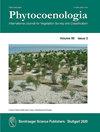内蒙古呼伦贝尔草原植被的植物社会学研究
IF 0.9
4区 生物学
Q4 ECOLOGY
引用次数: 7
摘要
本文首次对欧亚草原最东端呼伦贝尔草原的植物群落进行了详细的植物社会学描述。利用植物社会学方法,对呼伦贝尔草原东西向轴线上的6个区109个样地的植被数据进行了采集。确定了五个主要phytosociological植物群落:草甸草原的Veronico incanae-Stipetum baicalensis,杂草的植被Cannabi-Sphallerocarpetum股薄肌,草原的粪便attenuatae-Stipetum茅,葱属植物的大量放牧草原polyrhizum社区,和Glycyrrhizo uralensis-Achnatherum splendens。研究结果表明,大芽蒲草可分为两个亚群,即麻陵草亚群和小叶锦鸡儿亚群。群落的排序表现出从西部干燥草原到东部湿润草原的强烈梯度。与20年前相比,地带性植物区系组成发生了巨大变化,由原来的优势区系为耐盐的多根草和锦绣草。水源地附近的群落物种丰富度低于典型草原带群落的物种丰富度。撂荒地的物种丰富度低于邻近的未开垦地。这些结果表明,放牧压力和耕作改变了该地区的植物区系组成,降低了物种丰富度。本文章由计算机程序翻译,如有差异,请以英文原文为准。
Phytosociology of Hulunbeier grassland vegetation in Inner Mongolia, China
The present study provides the first detailed phytosociological description of the plant communities of Hulunbeier grassland, the easternmost part of the Eurasian steppe. Using phytosociological methods, vegetation data were collected from 109 plots in six areas spanning 300 km and covering a large proportion of the east-west axis of Hulunbeier steppe. Five main phytosociological plant communities were identified: meadow steppe of Veronico incanae-Stipetum baicalensis, ruderal vegetation of Cannabi-Sphallerocarpetum gracilis, steppe of Poo attenuatae-Stipetum grandis, heavily grazed steppe of Allium polyrhizum community, and Glycyrrhizo uralensis-Achnatherum splendens. The Poo attenuatae-Stipetum grandis was divided into two subunits: a Potentilla acaulis subassociation and a Caragana microphylla subassociation. The ordination of the communities showed a strong gradient from the drier western steppe to the wetter eastern steppe. Compared with 20 years ago, the zonal floristic composition had drastically changed from S. krylovii being dominant to the salt-tolerant A. polyrhizum and A. splendens becoming dominant. Species richness was lower in the communities nearby water sources suggesting intensive grazing and tramping than in the typical community of the steppe zone. Species richness was lower in the abandoned fields than in adjacent uncultivated sites. These results suggest that both grazing pressure and cultivation had changed the floristic composition and decreased the species richness in the area.
求助全文
通过发布文献求助,成功后即可免费获取论文全文。
去求助
来源期刊

Phytocoenologia
生物-植物科学
CiteScore
2.60
自引率
0.00%
发文量
7
审稿时长
>12 weeks
期刊介绍:
Phytocoenologia is an international, peer-reviewed journal of plant community ecology. It is devoted to vegetation survey and classification at any organizational and spatial scale and without restriction to certain methodological approaches. The journal publishes original papers that develop new vegetation typologies as well as applied studies that use such typologies, for example, in vegetation mapping, ecosystem modelling, nature conservation, land use management or monitoring. Particularly encouraged are methodological studies that design and compare tools for vegetation classification and mapping, such as algorithms, databases and nomenclatural principles. Papers dealing with conceptual and theoretical bases of vegetation survey and classification are also welcome. While large-scale studies are preferred, regional studies will be considered when filling important knowledge gaps or presenting new methods.
 求助内容:
求助内容: 应助结果提醒方式:
应助结果提醒方式:


